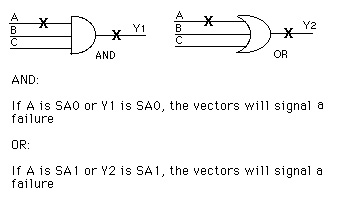Faults and Fault Detection
Last Edit July 22, 2001
Fault Types
Faults may be indeterminate in value (suspended between logical 1 and
logical 0), or determinate in value (exhibiting a 0 or a 1).
They may be transient (intermittent, time varying), in which case they
are elusive and difficult to detect. Faults may be permanent, i.e., considered
hard or solid, in which case they may be detected if they are not masked,
i.e., are observable.
Multiple faults occur when more than one fault occurs at one time. The
probability of multiple faults occurring in a circuit is relatively less
than the probability of a single fault, but is increasing with the increase
in circuit density. Single faults remain the most likely event.
Multiple faults can occur in such a manner that they can be degraded
to an equivalent single fault. In this case, the input vectors that test
for the occurrence of the single fault also test for the occurrence of
the multiple fault condition.
Fault Equivalencies
There are several equivalencies that exist which are useful in fault
detection and which make fault location potentially more difficult. Some
of these equivalencies are shown in Table 9-2 and two cases are
diagrammed in Figure 9-1.
Table 9-2 Fault Equivalencies
- One or more inputs to an OR gate stuck at 1 is equivalent to the
output of the OR gate stuck at 1.
- One or more inputs to an AND gate stuck at 0 is equivalent to the
output of the AND gate stuck at 0.
- All inputs to an OR gate stuck at 0 is equivalent to the output of
the OR gate stuck at 0.
- All inputs to an AND gate stuck at 1 is equivalent to the output
of the AND gate stuck at 1.
- Failure of at least one input and the output (multiple faulting)
will result in the output fault being propagated, masking the input
faults.
- Any gate output fault has, as equivalent, one or more single gate
input faults (the inputs not necessarily inputs to that gate).
- Any gate input fault does not necessarily have an equivalent gate
output fault.
Figure 9.1 Fault Equivalencies

|